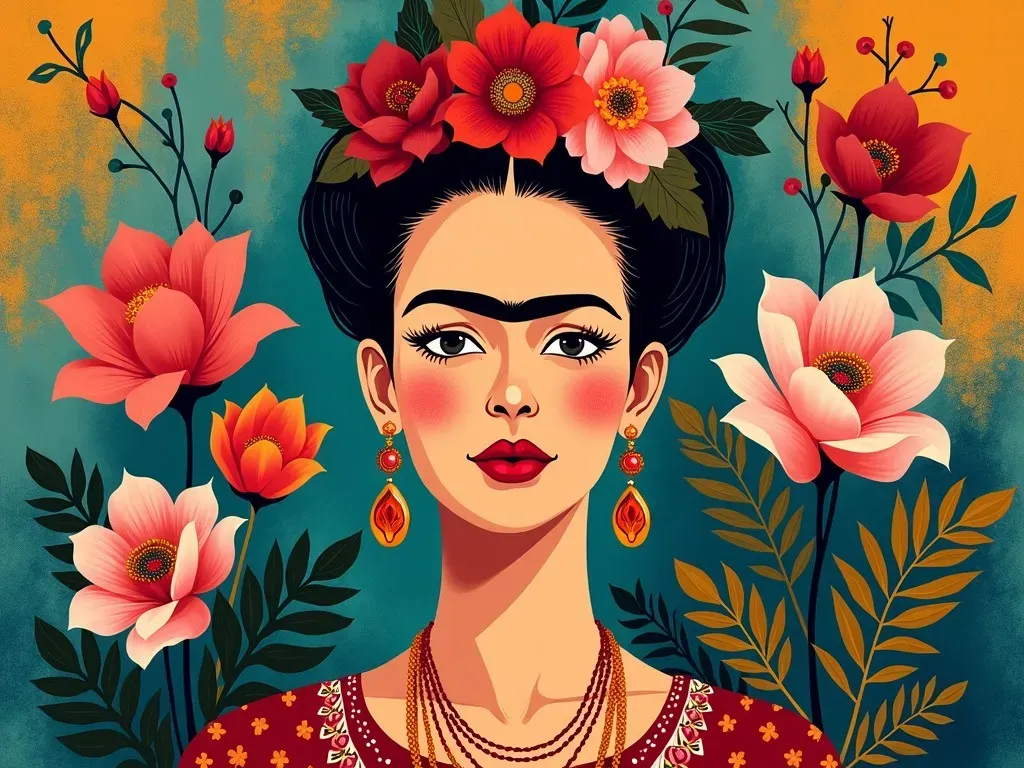Frida Kahlo, a highly celebrated Mexican painter, often used flowers in her artwork to express her emotions, identity, and cultural roots. Her floral representations not only add vibrant color and texture to her paintings but also carry profound symbolism reflecting her life experiences. This article explores the significance of flowers in Frida Kahlo’s art, delving into the meanings behind her floral motifs and how they encapsulate her story.
The Symbolism of Flowers in Kahlo’s Art
Frida Kahlo’s artwork employs flowers in various ways, manifesting through her self-portraits and other pieces. Flowers symbolize fertility, beauty, and the duality of life and death. From the joyful blooms to the thorny cacti, the floral elements in her work reflect her struggles and triumphs.
Key Floral Themes in Kahlo’s Work
| Theme | Description | Examples |
|---|---|---|
| Fertility | Symbolizing life, growth, and womanhood | “Flower of Life” (1943) |
| Death | Representing the transient nature of life | “Magnolias” (1945) |
| Identity | Reflections of her Mexican heritage and femininity | Self-portraits with flowers in her hair |
| Pain | The juxtaposition of beauty and suffering | “Self Portrait Dedicated to Dr. Eloesser” (1940) |
The Personal Touch: Kahlo’s Own Garden
Frida Kahlo’s home in Coyoacán, known as Casa Azul, was not just a personal refuge but also a garden brimming with native Mexican plants and flowers. This space allowed her to cultivate a deep connection with nature, which heavily influenced her artistic expressions. The vibrant flora around her served as both Inspiration and a representation of her complex emotions.
Flowers as an Expression of Identity
Kahlo is well-known for her signature flower crowns. These crowns, often made of vibrant local flowers, served multiple functions:
- Cultural Connection: Emphasizing her Mexican heritage.
- Feminine Identity: Highlighting her strength as a woman.
- Personal Expression: Reflecting her emotional states during various life stages.
Kahlo’s choice to adorn herself with flowers speaks volumes about how she wished to be perceived and how she navigated her tumultuous life. For example, during bouts of happiness, she might wear brighter, more colorful blooms, while in times of despair, the choice of flowers could reflect a darker palette.
Reference Video
Interpretation through Key Paintings
Frida Kahlo’s paintings provide insights into her emotional landscape, with flowers serving as the central motif. Below are notable artworks where flowers play significant roles:
-
“Flower of Life” (1943)
- Description: Features a mandrake plant, representing sexuality and fertility.
- Interpretation: A commentary on her own complex relationships.
-
“Self-Portrait Dedicated to Dr. Eloesser” (1940)
- Description: The artist is depicted with a necklace of thorns, surrounded by blooms.
- Interpretation: The flowers symbolize beauty alongside the pain of her tumultuous relationship with Diego Rivera.
-
“Magnolias” (1945)
- Description: Showcases magnolias alongside a pear cactus flower.
- Interpretation: Represents life and death—a theme recurring throughout her life and art.
Facts & Figures: Kahlo and Her Florals
- Total Flowers in Paintings: Over 30 different species of flowers were identified in her artworks.
- Cultural Significance: Many of these flowers are tied to Mexican folklore and traditions.
- Symbolic Meanings: Different flowers symbolize various aspects of her identity, such as pain, femininity, and strength.
Top 5 Flowers Most Frequently Used by Kahlo:
| Flower | Meaning |
|---|---|
| Sunflowers | Adoration and loyalty |
| Cacti | Resilience and survival |
| Jasmine | Love and sensuality |
| Bougainvillea | Passion and beauty |
| Marigold | Connection to death and the afterlife |
Cultural Context and Inspiration
Kahlo’s work does not exist in a vacuum; it draws from rich cultural sources and Mexican traditions. The significance of flowers in Mexican culture can be traced back through history, where they symbolize fertility, life, and death.
The Role of Mexican Culture
Kahlo’s work is a fusion of personal narrative and cultural symbolism:
- Folk Art Influence: Her paintings often reflect traditional Mexican folk art Techniques.
- Political Symbolism: Flowers can symbolize her revolutionary spirit and connection to the earth.
For a deeper understanding of the cultural significance, you can visit The Hidden Meanings In Frida Kahlo’s Paintings.
Flowers and Feminism in Kahlo’s Work
Kahlo wasn’t just an artist; she was a feminist icon whose use of flowers challenges conventional representations of women in art. The abundance of floral elements serves to reclaim femininity, merging beauty with the struggle against societal norms.
Feminist Interpretation of Floral Iconography
- Empowerment: Kahlo’s use of flowers illustrates her embrace of femininity.
- Contradictions: By juxtaposing beauty and pain, she highlights women’s complex realities.
Frequently Asked Questions (FAQs)
Q1: What do the flowers in Kahlo’s paintings symbolize?
A1: The flowers symbolize various themes such as fertility, beauty, identity, and the duality of life and death.
Q2: Why did Frida Kahlo wear flower crowns?
A2: Flower crowns represented her connection to her Mexican heritage, her expression of femininity, and her emotional states.
Q3: How many different flowers are depicted in Khalo’s art?
A3: Over 30 different species of flowers have been identified in her paintings, each carrying its own symbolic meaning.
Q4: What role did Kahlo’s garden play in her art?
A4: Kahlo’s garden at Casa Azul served as a source of inspiration, reflecting her deep connection with nature and her emotions.
Q5: Can Kahlo’s floral motifs be linked to her personal life?
A5: Yes, her portrayal of flowers often mirrors her emotional struggles, relationships, and her personal journey through pain and resilience.
The interplay of flowers in Frida Kahlo’s art serves as a vivid reflection of her life, thoughts, and profound connection with her Mexican identity. Each bloom tells a story, bringing forth layers of meaning that continue to resonate with audiences worldwide.
